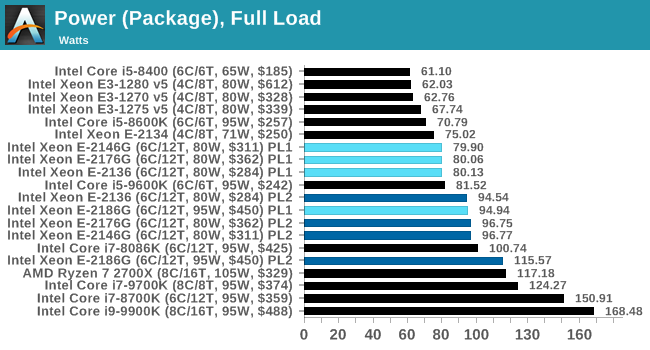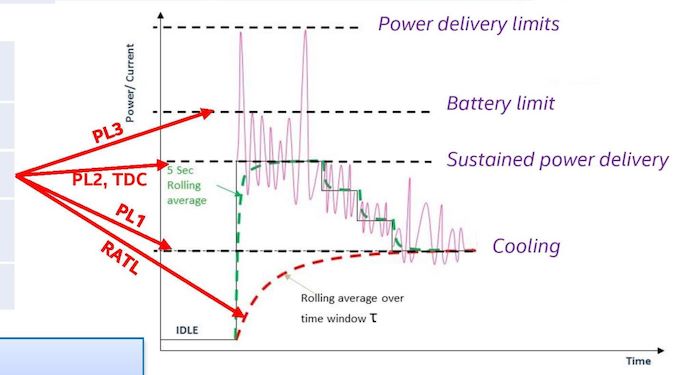Intel Xeon E Six-Core Review: E-2186G, E-2176G, E-2146G, and E-2136 Tested
by Ian Cutress on November 5, 2018 12:00 PM EST- Posted in
- CPUs
- Intel
- Xeon
- Enterprise CPUs
- Xeon E
Power Consumption
How TDP Works
Over the last decade, while the use of the term TDP (thermal design power) has not changed much, the way that processors use a power budget has. Inside each processor, Intel defines several power levels based on the capabilities and expected operating environments. This sounds all well and good, however these power levels and capabilities can be adjusted at the firmware level, allowing OEMs to decide how they want the processors to perform in their systems. Ultimately it gives a really fuzzy reading at exactly what the power consumption of a processor will be when it is in a system.
To simplify, there are three numbers to be aware of. Intel calls these numbers PL1 (power level 1), PL2 (power level 2), and T (or tau).
- PL1 is the effective long-term expected steady state power consumption of a processor. For all intents and purposes, the PL1 is usually defined as the TDP of a processor. So if the TDP is 80W, then PL1 is 80W.
- PL2 is the short-term maximum power draw for a processor. This number is higher than PL1, and the processor goes into this state when a workload is applied, allowing the processor to use its turbo modes up to the maximum PL2 value. This means that if Intel has defined a processor with a series of turbo modes, they will only work when PL2 is the driving variable for maximum power consumption. Turbo does not work in PL1 mode.
- Tau is a timing variable. It dictates how long a processor should stay in PL2 mode before hitting a PL1 mode. Note that Tau is not dependent on power consumption, nor is it dependent on the temperature of the processor (it is expected that if the processor hits a thermal limit, then a different set of super low voltage/frequency values are used and PL1/PL2 is discarded).
So let us go on a journey where a large workload is applied to a processor.
Firstly, it starts in PL2 mode. If a single-threaded workload is used, then we should hit the top turbo value as listed in the spec sheet. Normally a single thread will consume nowhere near the PL2 power limit. As we load up the cores, the processor reacts by reducing the turbo frequency in line with the per-core turbo values dictated by Intel. If the power consumption of the chip hits the PL2 value, then the frequency is adjusted so PL2 is never exceeded.
When the system has a substantial workload applied for a fixed time, in this case ‘tau’ seconds, the firmware should immediately invoke PL1 as the new power limit. The turbo tables no longer apply.
If the workload applied produces a power consumption above PL1, then the frequency and voltages are adjusted such that the overall power consumption of the chip is within the PL1 value. This usually means that the whole processor reduces in frequency, often to the base frequency, for the duration of the workload. This means that temperatures on the processor should decrease, increasing the longevity of the processor.
PL1 stays in place until the workload is removed and a CPU core hits an idle state for a fixed amount of time (usually sub 5-seconds). After this, the system can re-enable PL2 again if another workload is applied.
So some examples of numbers here – Intel lists several in its specification sheets for the different processors. In this case, I will take a consumer grade Core i7-8700K. For this processor, we have the following:
- PL1 = TDP = 95 W
- PL2 = TDP * 1.25 = 118.75 W
- Tau = 8 seconds
In this case, the system should be able to boost up to ~119W for eight seconds, before being pulled back down to 95W. This has actually been in place for a number of generations of processors, and most of the time it didn’t actually matter, as the power draw for the full chip was often well below the PL1 value even at full load.
However, this is where it gets really stupid: the motherboard vendors got involved, because PL1, PL2 and Tau are configurable in firmware. Motherboard manufacturers can do what they like, and that gets frustrating
With a commercial product like Xeon E, we would expect a motherboard to adhere to Intel’s standards moreso than a high-end consumer motherboard, right? Well we do.

The high-end Xeon E-2186G has a TDP of 95W, and a PL2 of 119W, and if we record the load power after a few seconds, it hits 116W. The long term power, measured about 20 seconds into the load, is 95W. For the other chips, they all have a TDP of 80W, and a PL2 of 100W, and we record the short load power at 95-97W, and the long load power at 80W. These numbers stayed true even when we run a workload for a considerable time – so while PL2 and Tau are both set to Intel recommended values. No other desktop processor we've tested has ever done this, unless it was bundled in an SFF system.











48 Comments
View All Comments
unsleepable - Thursday, November 8, 2018 - link
Any word on the lower-power members of the family? I imagine Intel will still release equivalents to previous generation processors like the Xeon E3-1260L v5, or counterparts to the i7 T CPUs like the Core i7-8700T, right?Chaitan - Saturday, November 10, 2018 - link
There is an interesting statement for these CPUs on ark: "Support for up to 128GB system memory capacity will be available in 2019 through a published BIOS Update. Please contact your hardware provider for availability and support."Does it mean that these will be the first mainstream CPUs with officially provided microcode for Intel memory controller to support 128GB?
Laptops with 128GB RAM support were announced several months ago by Dell, Lenovo and MSI (the latter with desktop CPUs and C246 chipset), but so far CPUs and BIOS for these laptops require custom OEM-specific CPU microcode for memory controller to really support such capacity.
Madao - Saturday, November 10, 2018 - link
I got lucky; got a 2176G on my doorstep from Provantage like Oct 20 for $330. X11SCA-W was in stock on newegg at the same time. I wanted the cheaper ASUS board but it was in stock nowhere.Really pisses me off that AMD and mobo makers dropped the ball on ECC. It should be standard in all computers and even phones. It only needs a few extra ram traces ffs --;
rannyjohns - Thursday, November 15, 2018 - link
I love your blog. And I always find something new here that I either hadn’t seen before or somehow managed to pass over. Thank you for this post! I am recently hoping to reach out and build my network in order to have more of a true collaboration going on, try more solution withasgehrj - Friday, December 14, 2018 - link
I'm not sure I agree that the only reason to get the top model is bragging rights.Agreed, turbo speed is very close to the lower end models, but:
It can sustain a 15% faster base clock than the lower end models, which is meaningful in e.g. render time. (It would almost equal an imaginary 7 core 2136)
"So buy a cpu with more cores" I hear you say...
True in most cases, but I'm building a 3D workstation, where the CAD application likes high single core clock speed , which is hard to find in the models with even more cores. The same machine also does the rendering, so in this case I'm pretty sure the 2186G (or the ..76G) is the better choice.